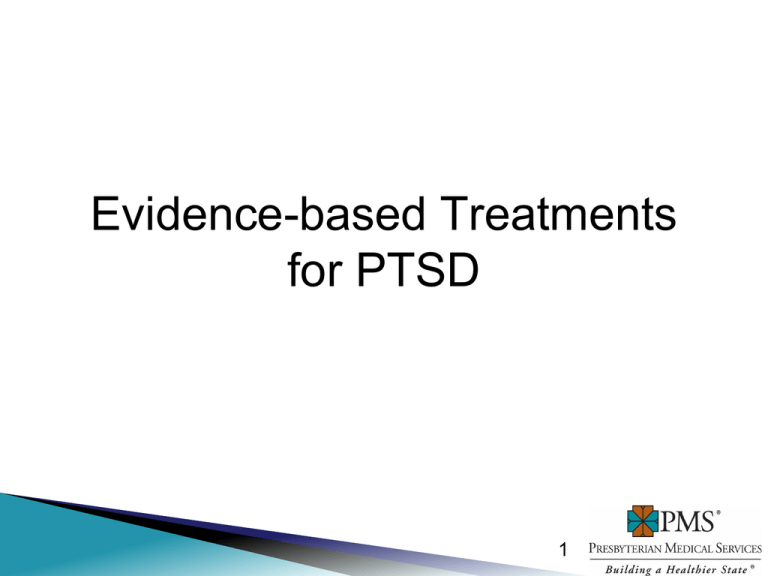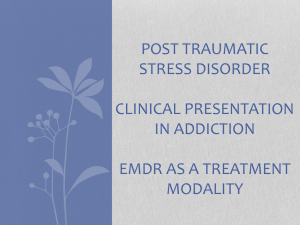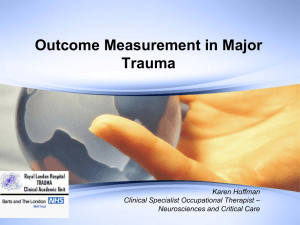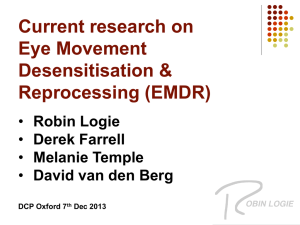Evidence-based Treatment Options for Trauma
advertisement

Evidence-based Treatments for PTSD 4/13/2015 4/13/2015 1 1 Natural Resiliency and recovery • Natural recovery occurs when survivors process through intrusions, thoughts and feelings • Doesn’t mean that survivors forget the trauma, or stop having intrusive all memories and distressing emotions. Healing can go on for years • Most people have a few issues but not enough to meet the criteria for PTSD (you have to meet all the sections to the get diagnosis) 4/13/2015 4/13/2015 2 2 Core Reactions • Escape and Avoidance • Research has shown that avoidance predicts chronic and severe post- traumatic stress. • Evidence based treatments are going to actively stop this and they are going to have to engage in at least the memory of the issues • The client may also appear functional; for example, holding down two jobs while getting a degree and raising a family in an effort to keep thoughts and feelings about a trauma at bay for years 4/13/2015 4/13/2015 3 3 Commonalities • All use a scale 1-10 or 1-100 for rating mood or a Standard Unit of Distress (SUD) • How you see and think about your past affects you’re here and now • See a disruption to the cognitive flow of thought leading to an anxiety reaction 4/13/2015 4/13/2015 4 4 Please Note •This is not met as a training in any one of these modalities but as an overview. 4/13/2015 4/13/2015 5 5 Medication • SSRI’s – Sertraline (Zoloft) 50 mg to 200 mg daily – Paroxetine (Paxil) 20 to 60 mg daily – Fluoxetine (Prozac) 20 mg to 60 mg daily • antidepressants for PTSD – Mirtazapine (Remeron) 7.5 mg to 45 mg daily – Venlafaxine (Effexor) 75 mg to 300 mg daily – Nefazodone (Serzone) 200 mg to 600 mg daily • Benzodiazepines – Lorazepam (Ativan) – Clonazepam (Klonopin) – Alprazolam (Xanax) 4/13/2015 4/13/2015 6 6 Evidenced Based Therapy Treatments • Cognitive Behavior Therapy – – – – – Seeking Safety Prolonged Exposure Therapy Stress Inoculation Training (SIT) Cognitive Processing Therapy (CPT) Other CBT including cognitive restructuring and cognitive therapy – Trauma Focused CBT (for children) • Eye-Movement Desensitization and Reprocessing (EMDR) – Brain Spotting 4/13/2015 4/13/2015 7 7 Seeking Safety • Developed by Lisa Najavits PhD and published in 2002 • 25 topic areas – research is on using all 25 topics • 5 central ideas to the program – – – – 1) safety is the priority of this first-stage of treatment 2) integrated treatment of PTSD and substance abuse 3) a focus on ideals 4) four content areas: cognitive, behavioral, interpersonal, and case management – 5) attention to the therapist processes 4/13/2015 4/13/2015 8 8 Seeking Safety • • • • • • • • Use of educational research strategies A focus on potential rather than pathology Attention to Language Relating the Material to Patients Lives Clinical Realism An urgent approach to time Making the treatment interesting to patients Practitioners do not have to be Master Level Clinicians 4/13/2015 4/13/2015 9 9 Seeking Safety • Check in • Ask client to read Quotation – Ask “What is the main point of the quotation” • Cover topic and handouts • Check – out 4/13/2015 4/13/2015 10 10 Problems • It is only covering the first stage of healing does not deal directly with the trauma • Is a dual diagnosis model so clients without substance abuse may balk at being in a group with those who are or bring up family issues • Clients who want to talk about what happened can not in group and may have issue with this 4/13/2015 4/13/2015 11 11 Prolonged Exposure Therapy • Developed by Edna Foa PhD • Used by the VA and has largest body of research behind it • Generally between 9-12 sessions but some bodies of literature say up to 18 sessions – To apply the evidence based model is 2 sessions per week 1.5 hours long 4/13/2015 4/13/2015 12 12 Prolonged Exposure • Two parts of the treatment – imaginal exposure - the memory of the traumatic event(s) done in the session – in vivo exposure – real life stimuli (people, places, things) that are reminders of the traumatic event or raise the anxiety level – Use of SUD throughout the sessions and homework • Relaxation training prior to the start of treatment to help with process • Is homework based 4/13/2015 4/13/2015 13 13 Problems • About a 20% drop out rate • High level of clinician avoidance to using the practice • Must have memory to recall and work on it • The client must be able to disclose what happened in detail 4/13/2015 4/13/2015 14 14 Stress Inoculation Therapy • Developed by Donald Meichenbaum PhD and first published in 1985 • patient education about anxiety • training in coping or anxiety management skills (i.e., deep muscle relaxation, breathing control, thought-stopping, assertiveness training, reassuring self-talk • SIT consists of 8 to 15 sessions, plus booster and follow-up sessions, conducted over a 3-to12-month period 4/13/2015 4/13/2015 15 15 Stress Inoculation Therapy • Three Stages – The first stage of SIT is called ‘conceptualization’ • The therapist helps the individual to identify their stressors and how they respond to these and how successful these responses have been. Patterns of self-defeating internal dialogue are identified. – The second stage is ‘skill acquisition and rehearsal’ • The therapist helps the individual to develop and practice positive coping statements to be used in stressful situations. Other techniques such as relaxation and making a realistic appraisal of situations are also practiced. – In the third stage ‘application and follow-through’ • the individual begins to apply the newly acquired skills to progressively more difficult situations in the real world. The therapist provides support and further training when necessary. 4/13/2015 4/13/2015 16 16 Problems • Does not deal with the memory so intrusive thoughts tend to still present as an issue • Smaller body of research and most of it is older not much in last 10 years • For clients who struggle with meditation, visualization, imagery you will find a high level of resistance 4/13/2015 4/13/2015 17 17 Cognitive Processing Therapy (CPT) • The original manual, published in 1993, was authored by Patricia A. Resick and Monika Schnicke • Is 12-14 sessions but can take more • In the Veterans’ Administration, there is increasing use of CPT in group format • Very cognitive based what we think affects how we act and feel • Use of Socratic style of interacting 4/13/2015 4/13/2015 18 18 Cognitive Processing Therapy (CPT) • CPT sessions are structured and each session has a structured part in the overall sessions • Each CPT session has three parts – Brief update that includes overall mood and PTSD symptoms – Review of assigned practice – Setting new practice assignment: demonstration and assignment to do at home 4/13/2015 4/13/2015 19 19 CPT • Two Key concepts – Assimilation information about the event is absorbed without changing prior beliefs. The new information maybe altered to match prior beliefs in order to reconcile information about the event with what was known before. It frequency serves as a process of engaging in undoing or self-blame for the trauma – Over-accommodation altering ones beliefs about oneself and the worked to the extreme to feel safer and more in control to reconcile information about the event with prior beliefs. It typically involves generalization trauma-based reactions to non-traumatic situations – targeted in the last 5 sessions 4/13/2015 4/13/2015 20 20 CPT • • • • • • • Use of Stuck Points Impact Statement ABC Worksheets Challenging Questions worksheet Patterns of Problematic Thinking worksheet Challenging Beliefs worksheet Issues topics: Safety, Trust, Power/Control, Esteem and Intimacy • Final impact statement/ Meaning of the Event 4/13/2015 4/13/2015 21 21 Problems • Can be adapted for illiterate populations but is a struggle also for those with TBI • For those who disliked Prolonged Exposure they feel it is to similar • Has about a 20% drop out rate • Must have the memory to work on the issue • More difficult with complex trauma 4/13/2015 4/13/2015 22 22 Other CBT including cognitive restructuring and cognitive therapy • Can vary on number of sessions from 5 - 52 • The therapist helps the patient to understand and change thoughts about trauma and its aftermath. The goal is to understand how certain thoughts about the trauma cause stress and make symptoms worse. • The patient learns to identify thoughts about the world and the emotional effect on them. With the help of a therapist, client will learn to replace these thoughts with more accurate and less distressing thoughts. Emphasis on coping skills with feelings such as anger, guilt, and fear. • Cognitive therapy helps the person understand that the traumatic event and see how it is a normal reaction to a crazy event. 4/13/2015 4/13/2015 23 23 Problems • Though CPT is the most researched other forms of CBT include use of narrative, psycho analytic, client centered and lack a formalized verifiable model that is followed consistently • Body of data can be confusing as to which is most beneficial numerous training methods and groups • Variance in numbers relating to completion factors with client and follow up long term varies with what variation was used 4/13/2015 4/13/2015 24 24 Trauma Focused Cognitive Behavioral Therapy TF-CBT • Created by Esther Deblinger in the late 1980’s at the New Jersey CARES Institute • Used for children and adolescence ages 3-18 • Number of sessions is generally 12 to 16 sessions once a week for 60-90 minutes • Has child and parent sessions as well as family sessions to address the trauma • The goal of TF-CBT is to help address the biopsychosocial needs of children and to a lesser extent their families with (PTSD) 4/13/2015 4/13/2015 25 25 Trauma Focused CBT • It combines humanistic, cognitive behavioral and familial strategies in this one therapy to address the PTSD in children • Both parents and children learn how to process their emotions and thoughts that relate to the traumatic experience and to change those ways of thinking • Establishing a secure environment and working on the though process around those memories is the primary focus 4/13/2015 4/13/2015 26 26 Trauma Focused-CBT • • • • • • • • • “PRACTICE” P - Psychoeducation and parenting skills—Discussion and education about child abuse in general and the typical emotional and behavioral reactions to sexual abuse; training for parents in child behavior management strategies and effective communication R - Relaxation techniques—Teaching relaxation methods, such as focused breathing, progressive muscle relaxation, and visual imagery A - Affective expression and regulation— Helping the child and parent manage their emotional reactions to reminders of the abuse, improve their ability to identify and express emotions, and participate in self-soothing activities C - Cognitive coping and processing— Helping the child and parent understand the connection between thoughts, feelings, and behaviors; exploring and correcting of inaccurate attributions related to everyday events T - Trauma narrative and processing— Gradual exposure exercises, including verbal, written, or symbolic recounting of abusive events, and processing of inaccurate and/or unhelpful thoughts about the abuse I - In vivo exposure—Gradual exposure to trauma reminders in the child’s environment (for example, basement, darkness, school), so the child learns to control his or her own emotional reactions C - Conjoint parent/child sessions—Family work to enhance communication and create opportunities for therapeutic discussion regarding the abuse and for the child to share his/her trauma narrative E - Enhancing personal safety and future growth—Education and training on personal safety skills, interpersonal relationships, and healthy sexuality and encouragement in the use of new skills in managing future stressors and trauma reminders 4/13/2015 4/13/2015 27 27 Problems • Child must be able to use basic communication skills around the trauma and be high enough functioning to engage in talk therapy • Is problematic with children who had conduct disorder prior to trauma so severe neglect cases have not done well • It has been focused on children who have fewer incidents of trauma some argue it has not been shown effective in those who have infancy and early childhood trauma • Poor results with children and adolescents with history of runaway behavior, suicidal and cutting behaviors 4/13/2015 4/13/2015 28 28 Eye-Movement Desensitization and Reprocessing (EMDR) • founded by Dr Francine Shapiro in 1990 • Number of session vary from 8 to 25 for basic trauma treatment • traumatic material need not be verbalized; instead, patients are directed to think about their traumatic experiences without having to discuss them or even have a clear memory of them • Sets of Eye movements with therapist and/or auditory or physical stimulation 4/13/2015 4/13/2015 29 29 EMDR • • • • • negative beliefs or negative cognitions Positive beliefs or positive cognitions 1-to-7 Validity of Cognition (VOC) Use of SUD scale frequently Three pronged protocol – Past – Present – Future 4/13/2015 4/13/2015 30 30 EMDR 8 phases of treatment History and Treatment Planning • 1-2 sessions Preparation • 1-4 sessions For use in each session of EMDR Assessment • Use of VOC & SUD scales Desensitization drop in SUD scale and reduction of negative cognitions 4/13/2015 4/13/2015 Installation • Use of positive cognitions and VOC scale Body scan body memories feelings of tension in the body Closure ending of session Every subsequent session has Reevaluation Are the changes in SUD and VOC sticking 31 31 Problems • Expensive to be trained in and even more to be certified in • Limited training opportunities • The brain mechanisms behind EMDR are still not understood • Clients may report feeling you are “doing” something to them instead of owning their process 4/13/2015 4/13/2015 32 32 Additional Treatments • (VRET) Virtual Reality Exposure Therapy • (ACT) Acceptance & Commitment Therapy • Behavioral Activation • (EFT) Emotional Freedom Technique • (NLP) Neuro-Linguistic Programming 4/13/2015 4/13/2015 • • • • • • • Meditation Hypnosis Massage Acupuncture Drumming/Music Dance and movement Spiritual/Religious Healing • Animal Healing 33 33 Summery • Different clients react differently to treatment and a growing body of evidence is developing to offer more choices and options to clients. • Each system has pluses and minuses for it and this needs to be taken into consideration when working with a given client 4/13/2015 4/13/2015 34 34 Questions? 4/13/2015 4/13/2015 35 35









